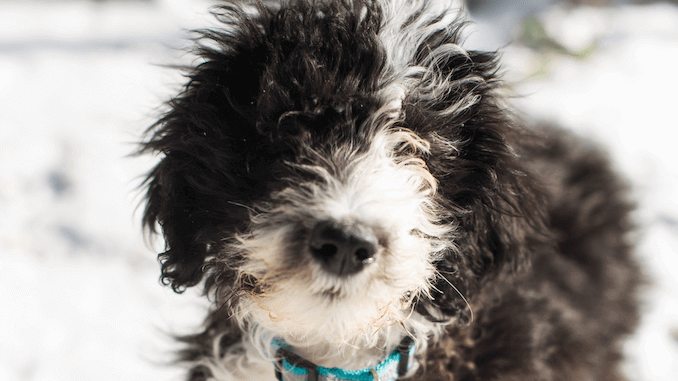
Sheepadoodle’s are obedient, friendly, and loving with an appearance that will make you fall in love with them immediately.
They are active, very easy to train, and kid-friendly; making them a perfect family dog.
The sheepdog poodle mix is not a pure dog breed.
It is a superb cross between a male Old English sheepdog and a female poodle.
This stunning breed is very popular for its cuddles, strong temperament, and loyal companionship.
In this article, we will consider their history and origin, temperament, lifespan, care requirements, and known health issues.
| Breed Type | Mixes and More |
| Purpose | Family Pet |
| Suitable For | Families |
| Size | Between 21″ and 22″ when fully grown between 18 months to two years old |
| Weight | Between 60 pounds – 75 pounds (male) or Between 45 pounds – 60 pounds (female) |
| Lifespan | 12-15 years a similar lifespan to an Old English sheepdog rather than a poodle |
| Color Variations | Black and White, Black, Red, and White |
| Temperament | Calm, playful, and intelligent |
| Daily Exercise | High |
| Activity Levels | Moderate to High |
| Daily Food Consumption | Should consume 1,300 calories per day as a dog and 2,100 calories as a puppy |
| Known Health issues | Hip dysplasia, elbow dysplasia, progressive retinal atrophy, cataracts, sebaceous adenitis, Addison’s disease, canine autoimmune thyroiditis |
TABLE OF CONTENTS
Sheepadoodle Breed Overview
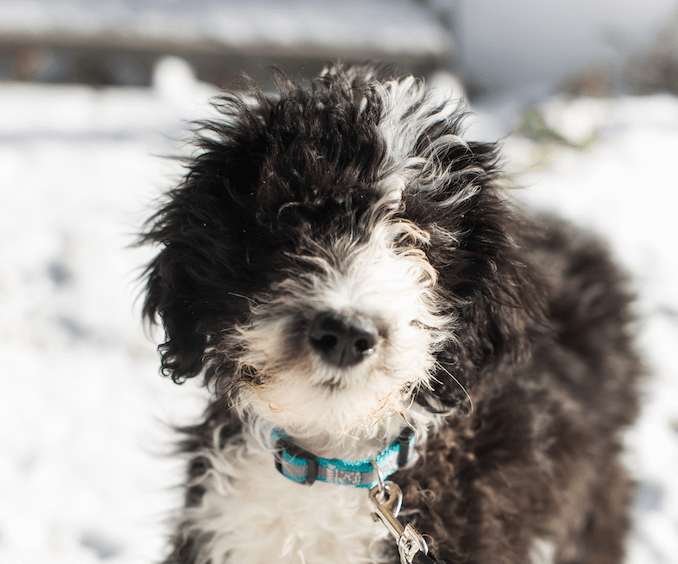
From Adobe Stock
The sheepadoodle, not to be confused with a shepadoodle, is an Old English sheepdog and poodle mix.
This fluffy canine is a crossbreed between a male Old English sheepdog and a female standard poodle.
Along with the other doodles, they are mostly known for their lack of shedding which makes them popular with people who have allergies (i.e. hypoallergenic dogs) and who want a relatively hair-free home.
Sheepadoodle History and Origin
When deciding if a breed is right for you, it is worth looking at their history and where they came from; it can somewhat predict their temperament and behaviors.
Sheepadoodles originated as an experiment in the 1960s by the US Army for use as a military dog.
The term “doodle” was first coined in 1992.
Since then we have seen schnoodles, goldendoodles, and now this breed.
It wasn’t until 2007 that these energetic, loving, and kind teddy bears first started to appear.
This dog is a cross between an Old English sheepdog and a standard poodle.
Crossbreeding of purebred dogs has been carried out for decades, in the hope of cherry-picking the most beneficial characteristics of certain breeds and losing less desirable traits or removing faults from a purebred.
We will now look at the characteristics and temperaments of the Old English sheepdog and standard poodle and some of the less desirable traits to understand the birth of the sheepdog poodle mix.
Standard Poodle Temperament

There are three different groups of poodles, the toy poodle, the miniature poodle, and the standard poodle.
| Purpose | Fowl hunting |
| Suitable For | Families |
| Size | Standard Poodle must be over 15 inches at the withers |
| Weight | 60 to 70 pounds (male) or 40 to 50 pounds (female) |
| Lifespan | 10-13 years |
| Color Variations | The coat must be a solid color and can be white, black, brown, silver, grey, silver beige, apricot, red, cream, sable, phantom, and brindle |
| Temperament | Active and Intelligent |
| Daily Exercise | High |
| Activity Levels | High |
| Known Health issues | Ear infections, Addison's disease, gastric dilation, thyroid issues, tracheal collapse, epilepsy, hip dysplasia, and juvenile renal disease |
Poodles historically have been used for fowl hunting; making them renowned water dogs.
Their intelligence ranks second in the world to the border collie, making them easy to command.
Poodles have a single layer, dense curly coat, which sheds minimally. The curly coat does require significant grooming to avoid tangles and matting; a trip to be clipped at the groomers every 8-10 weeks should be expected.
They are usually described as being hypoallergenic, therefore popular with allergy sufferers.
Poodles adapt well to family environments but they are less tolerant of being left alone. Their various health issues are also of concern (see table above).
We will now look at the other part of the mix, the Old English sheepdog.
Purebred Old English Sheepdog Temperament
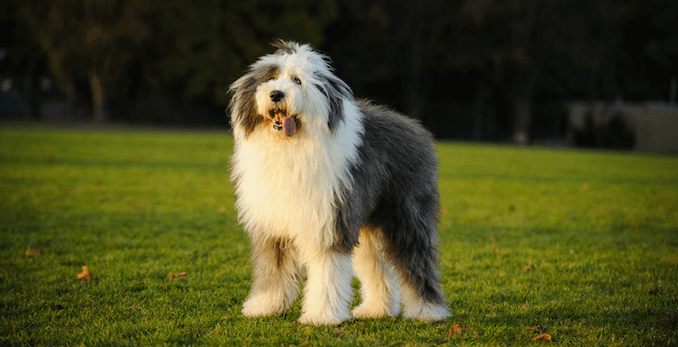
| Purpose | Historically, the Old English sheepdog was a drover, helping farmers to drive cattle and sheep to market |
| Suitable For | Active Roles and Families |
| Size | 22" and above at the withers (male) and 21" and above at the withers (female) |
| Weight | 80 to 100 pounds (male) or 60 to 85 pounds (female) |
| Lifespan | 10-12 years |
| Color Variations | Blue, Blue Merle, Grizzle |
| Temperament | Adaptable, Gentle, and Smart |
| Daily Exercise | High |
| Activity Levels | High (but with rest) |
| Known Health issues | Hip dysplasia, von Willebrand's disease, deafness, gastric torsion, retinal detachment, progressive retinal atrophy and cataracts |
They are known for being watchful, courageous, incredibly loyal to their owners, and therefore make brilliant family pets.
They are mostly recognized by their long shaggy coat; this places them rather high on grooming requirements.
Unfortunately, the UK Kennel Club has placed the Old English sheepdog on their 2018 Breed Watch list.
This means there are visible points of concern for the breed:
- Excessively long coats
- Excessively profuse coats
- Cow hocks (The hock is set inward causing a splayed look in the back legs)
- Weak hind movement
This goes some way to explaining why purebred dogs are being crossed, in the hope of producing a dog with the positive traits and health of certain breeds and out-breeding the negative traits and health.
So what has been produced with the sheepadoodle? We will now have a look in a little more detail.
Sheepadoodle Temperament, Breed Personality and Behavior: Things to Keep in Mind
Most owners describe their sheepadoodle puppies as calm tempered, playful and intelligent.
They boast a friendly nature which makes them popular in families.
Some sheepdog poodle mixes have even been successful service and guide dogs.
Despite Old English sheepdogs being brilliant family dogs and described as people-pleasers, it is this very quality that can result in destructive behavior if left alone.
Poodles rank very highly for intelligence and it is this quality that can result in unwanted destructive behaviors and excessive barking if not appropriately stimulated.
Although all potential owners seek those earlier positive traits in their dog, it must be remembered that with a crossbreed you could end up with traits from either side of the spectrum.
How to Care for a Sheepadoodle
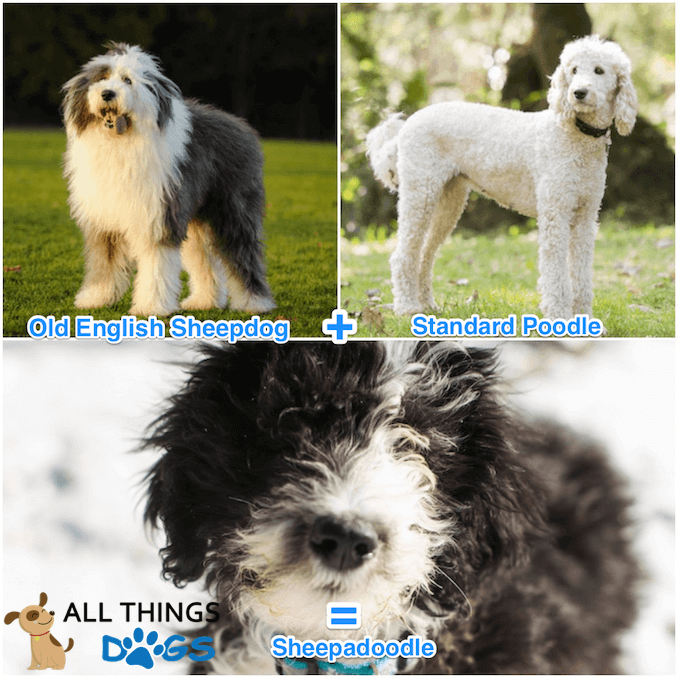
Food and Diet Requirements
The dog food market can be overwhelming.
Canned food, kibble, dehydrated and raw are just a few options available to owners.
When considering what to feed your dog, do your research, speak with other dog owners and speak with your veterinarian. Consider both lifestyle and budget.
Your dogs will require around 25 calories per lb per day to keep their current weight.
He should be fed around 1,300 calories per day once matured; this can rise as high as 2,100 calories whilst they are a puppy.
Top-Tip
This big pooch matures at a similar age to giant breeds, don’t transition your dog’s diet until they are full matured.
| 1,300 calories | 2,100 calories |
All feed manufacturers should provide guidance on amounts to feed your dog; remember this is based on the expected weight of your dog.
So, for puppies, you should be considering how big your dog will get.
When fully grown, you should be feeding based on the ideal weight of your particular breed.
For a dog this big, it can vary between 60 to 90lbs based on their parents.
You should speak with your breeder and veterinarian. The sire and dam of your puppy will give you a good indication on how big they will get.
Puppy feeds should ideally be split into 4 meals a day.
This is to avoid over-stretching their stomachs and to give them chance to digest the food fully.
From approximately 6 months old, this can be reduced to 2 meals a day.
Most owners continue with 2 meals a day for the duration of their dog’s lives.
It is easy to monitor if you are feeding your dog correctly.
In determining whether your dog is a healthy weight, you should be able to see a waistline, feel the ribs, and from a birds-eye view, your dog should have an hourglass outline.
If you have any concerns about your dog’s weight, see your veterinarian.
Remember, fresh water should always be available to your dog.
Exercise Requirements
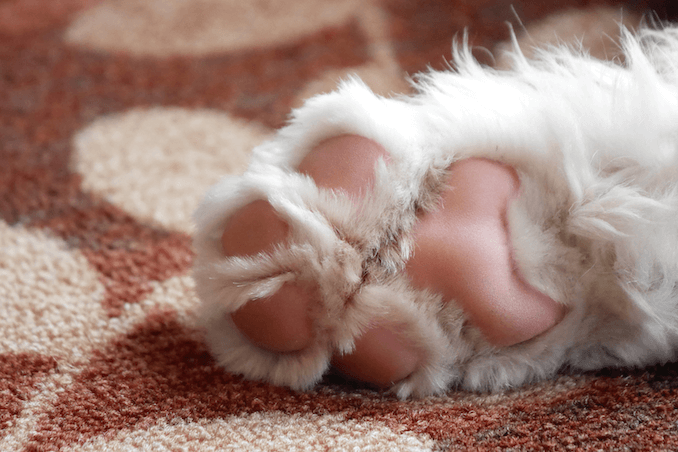
Not surprisingly, they frequently inherit the sheepdog’s herding genes and the poodle’s fowl hunting genes.
She will require daily walking.
As a puppy, remember the 5-minute rule.
A 5 minute walk per month of their age. So a 4-month-old puppy shouldn’t be walked for any longer than 20 minutes twice a day. This is particularly important in the larger breeds due to the length of time it takes them to reach full maturity.
Once matured, typically after 18 months, you should walk your dog for 60 minutes a day.
Over-exercising and too much physical activity can be of detriment to a dog’s development.
When you’ve hit your daily quota for physical exercise, move on to mental stimulation for this highly intelligent and trainable dog.
Training Requirements
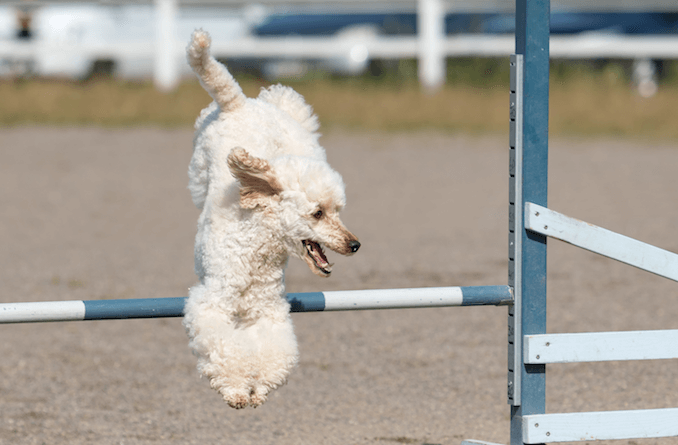
Training any dog is a challenge, even for experienced owners.
Most owners report their pooch as being easy to train, but this is generally to do with their people-pleasing trait and high levels of intelligence.
Let’s not get complacent though, there are some key puppy training tips when training any dog:
- Early Socialization
- Positive Reinforcement (i.e. reward-based training)
It has been frequently established that well-socialized puppies are less likely to exhibit problematic aggressive adult behaviors, stemming out of fear and anxiety.
When we say socialization, we mean exposure to experiences, people, and objects from a young age, in a calm and non-pressured way.
So, in a safe environment, expose your puppy to:
- People wearing hats, hooded sweatshirts, coats, tall people, short people, children,
- Household items such as the washing machine, vacuum, dishwasher;
- Animals – domestic and farm (i.e. sheep) where possible.
Socialization with other friendly dogs is also important.
Of all shapes and sizes.
Some veterinarians and trainers run dog socials where there is a managed environment for dogs to play.
When introducing your dog to other dogs and people, watching their dog body language, is key to stopping a potential disaster.
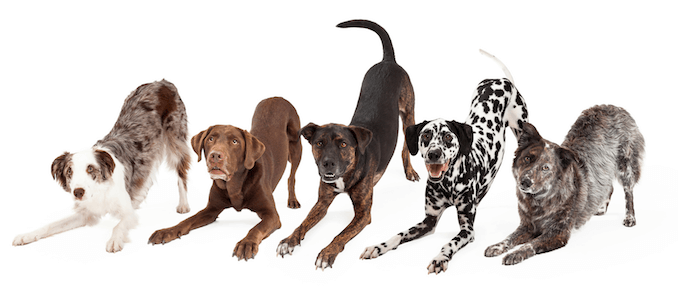
When training situations with your sheepadoodle are going well; it is important to reward your dog, so they know what behavior is wanted.
It has been discovered that the most effective methods when training dogs are positive reinforcement and reward-based training.
The use of punishment during training actually results in an increase in problematic behaviors.
These problematic behaviors usually manifest as barking and aggression towards people, barking and nipping at other dogs, and growling.
It is thought that these behaviors are a result of fear and anxiety developed through the use of punishment.
So if we want a well-rounded, sociable dog, there are a few reward-based approaches we can use when our pooch is displaying the behavior we want:
- Play reward – balls, toys, etc.
- Food reward – high-value treats
- Praise reward – “Who’s a good boy!”
We can also ignore unwanted behavior and provide alternatives.
So if Fido desperately wants to chew that draught excluder by the back door, move the excluder and distract him with a chew rope all of his own.
We know that bored dogs can become destructive, so being a keen trainer is key.
So they need daily exercise, frequent training, anything else?
Grooming
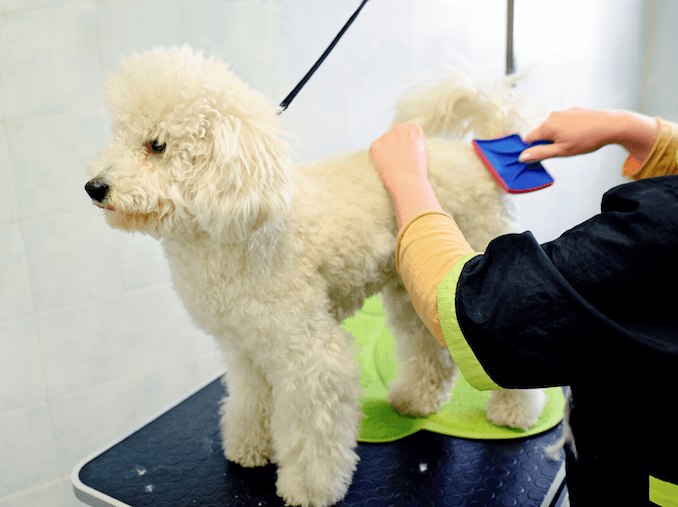
This mix was made to be a hypoallergenic dog as a result of their poodle genes.
Poodles shed hair, but minimally.
Some of these dogs have flat and straight fur, whilst others may have some wavy coats; however, this will never be curly like a poodle.
Due to their curly coat, it traps the hair that is shed and also the dander, so not as much is released into the environment.
This makes them popular with allergy sufferers.
The curly-wavy coat requires regular grooming to prevent knots and matts from forming.
Expect to brush your pooch 2-3 times a week (as a minimum, daily is better) to keep his coat in top condition.
Most large fluffy pooches like this are regularly clipped to keep their hair at a more manageable length, this can vary from every 8-12 weeks.
Due to the renowned ear infections in poodles, it is worth regularly cleaning and checking your dog’s ears when you groom their coat.
Regular teeth brushing is a must and also keeping their nails trimmed – a groomer can do this for you, or your veterinarian.
Sheepadoodle Appearance: Coat and Color
The appearance of sheepadoodle puppies is very similar to that of a standard poodle with regards to size and weight.
They have three color variations, with the most common being black and white:
- Black and White
- All Black
- Red and White
However, due to her parents both carrying the D-Locus gene (Dilute Coat Color), this often results in their coats fading to an old English sheepdog gray.
As this dog is a crossbreed and not a purebred, there can sometimes be inconsistency with coloration.
Typically, Red and White is a result of a red standard poodle, whereas the other color variations are from a white or cream standard poodle.
She boasts a long curly single coat.
You may also like the goldendoodle if you like the sheepadoodle.
Known Health Problems
It is also important to be aware of health issues prevalent in the breed.
We have briefly mentioned them in the quick summary earlier, we will now explore these in more detail.
Like any breed of dog, they are susceptible to certain diseases.
Although the cross-breeding hopes to only continue the positive traits, it isn’t possible to know for certain how a puppy will turn out.
What we do know, is that doodles (any cross with a poodle) often have these health problems:
- Hip dysplasia: this is where a dog’s hips weaken, deteriorate, and become arthritic. It can range from mild to severely disabling and stems from abnormal development of the hip joint. Large breeds are more predisposed to hip dysplasia due to their rapid growth. It is recommended that both parents are hip scored to establish the risk posed to any puppies they have.
- Elbow dysplasia: This is the same as hip dysplasia but occurs in the elbow, again resulting in weak, arthritic joints. An X-ray is usually carried out to grade elbows in prospective parents. Poor grading should not allow the dogs to be bred from.
- Cataracts: Poodles are infamous for having cataracts. Most dogs susceptible to cataracts undergo annual eye tests. Most owners first notice problems when their dogs are bumping into furniture. Cataracts can quite often be treated through surgery, however.
- Sebaceous Adenitis: Poodles also suffer from this skin disorder. With this disorder, the dog’s sebaceous glands become inflamed and eventually die. When they no longer function, the following symptoms usually present: hair loss, thickening of the skin, musty odor, and secondary skin infections.
- Addison’s Disease: This is when the dog’s body doesn’t produce enough cortisol. A vital hormone for daily functioning. This is a common disease found in poodles. Symptoms include, excessive drinking and urinating, increased heart rate, and panting.
- Canine Autoimmune Thyroiditis: This is the presence of anti-thyroid anti-bodies that slowly deplete the thyroid gland. Low levels of thyroid function in dogs are generally indicative of the disease. Treatment is possible in the form of daily medication and it’s essential.
Five Fun Sheepadoodle Facts
- The breed originated as an experiment in the 1960s by the US Army for use as a military dog.
- They are a cross between an Old English sheepdog and a Standard Poodle.
- The term “doodle” was first coined in 1992.
- They frequently inherit the sheepdog’s herding genes and the poodle’s fowl hunting genes.
- The sheepdog poodle mix has three color variations, with the most common being black and white.
Summary
So, that’s the sheepadoodle.
A highly intelligent, calm, and playful dog.
Good for families, but remember they need a lot of exercise and mental stimulation.
They also aren’t too keen on being left alone.
Keep in mind it is still a cross-breed, so despite all best efforts to carry on the more desirable traits from the Old English Sheepdog and the Poodle, your dog could still end up with the less desirable traits and the associated health problems.
Do you own a sheepadoodle, or are you thinking of getting one of these adorable breeds? Let us know in the comments below.
Other Poodle Mixes
If you’re interested in learning about other poodle mixes, check out the hybrid dog breeds below.
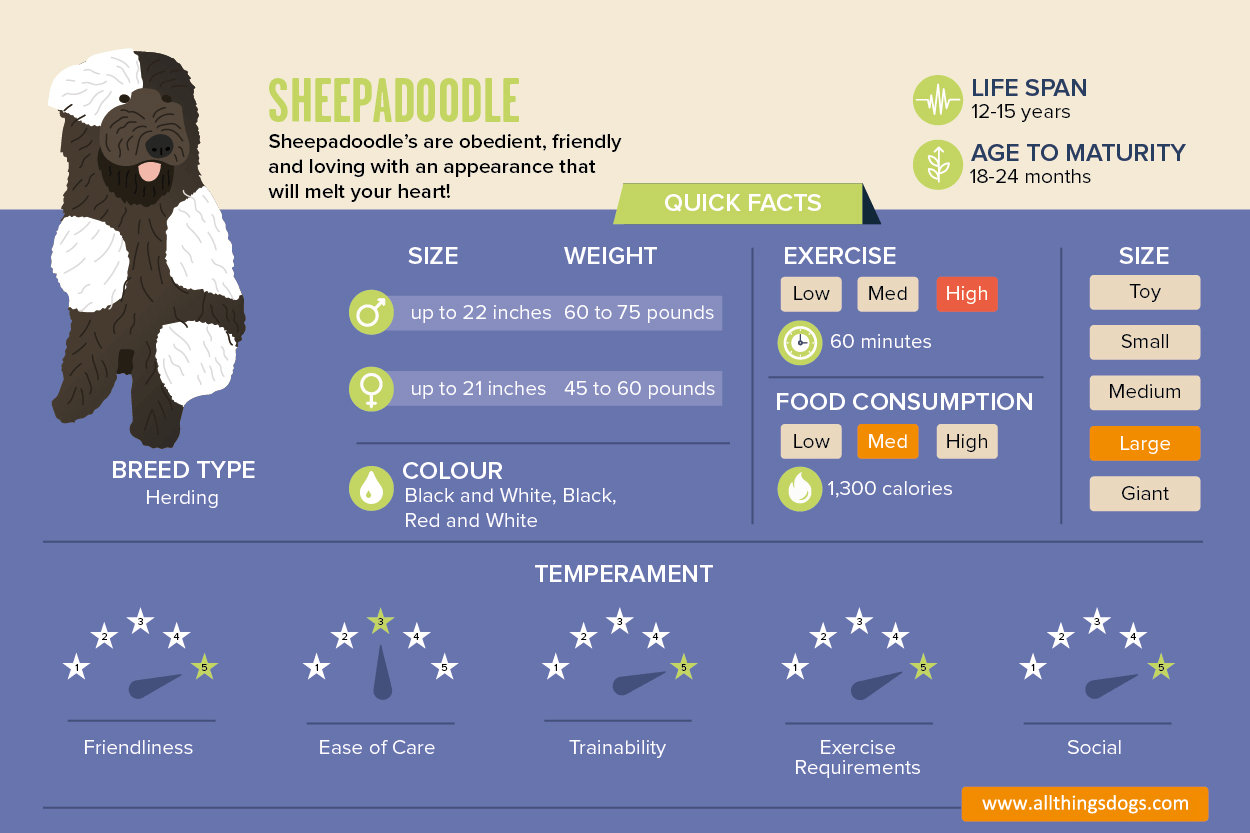



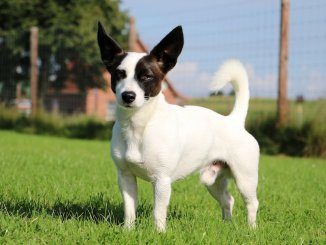
I have a 14 month old sheepadoodle. He is the most wonderful dog I’ve ever owned. I’ve had 3 standard poodles over the years and thought I would never Owen another breed, but always loved the goofy sheep dog. When I had to put my last poodle down from stomach cancer, I saw a picture of a two day old sheepadoodle. It was love at first sight. I must say though, that had I not been retired I’m not sure I would have been able to handle him. He is now 31 inches at the withers and 70 pounds, and full of energy. In the evening if he doesn’t get enough exercise he goes psycho running up and down the hall bouncing off the couch or chairs. We just adopted a 3 year oOld English sheepdog so he would have someone to play with. Very easy to train (when he wants). With his new friend it’s 2 trips to the park almost everyday. I can’t describe how much this puppy is loved and what a great addition to my husbands and my life. My only recommendation is to research before committing to get one. Lyn
We have a 5 yr old female, she is the most loving, and goofy dov I have ever had. She cN be sneaky and with her height she is quiet the counter surfer? her grooming isnt intense but we we tend to keep her coat shorter. She follows her human brother everywhere and a short coat is just easier. She is happy, loves to be loved, she loves me but really wants all the attention from my husband. As far as activity level, she tends to follow the house- if the 7yr old is being wild and crazy then she is. She is content with running circle in the back yard then sleeping the rest of the day in someone’s lap.
We’ve just had our male Sheepadoodle 9 days and he’s 9 weeks old. Living in a high rise, maybe this wasn’t the most practical choice but we LOVE him. Training is tough but worth it.
I have a new edition, 14 week old Sheepadoodle. He’s a bundle of energy, loves to snuggle and mostly loves to bite, nip and herd everything. We are still battling for the alpha spot and have many debates why “potty” belongs outside. He really does look like a stuffed toy.
We’re getting a sheepadoodle in May! We are so excited. This will be our first time owning a pup. We both had dogs when we grew up but now we are starting from scratch. Are these dogs ok to take on runs after 18 months?
Hi MacKenzie, you can read our article on running with your dog, and also try dog anatomy which explains growth plates and the fusing of them. My advice would be to wait until he is 2 years old, and to start with very short and gentle runs. Hope this helps.
Is anyone aware of any UK breeders of Sheepadoodles? I am looking for one
I am looking for sheepadoodle breeder in the UK, can anyone recommend please?
We have a dark red female standard poodle . Our friends are about to purchase a male Sheepadoodle. We are wondering your opinion on our breeding these two down the road .
Hi Michelle, Responsible breeding of any dog should take into account their temperament and health. Consider the common health issues found in the Sheepadoodle and also with the standard poodle, specifically hip and eye issues. Individual tests can help you decide whether your dogs are healthy enough to breed from. The age of the breeding dogs will also largely affect your decision. You should also consider the inbreeding coefficient due to the poodle lines contained in the Sheepadoodle but the most important question to ask is your reason for wanting to breed from the dogs.
We are picking our new Sheepadoodle out tomorrow morning. There are only two pups left. One seems to be on calmer side and one of the smallest in the litter, but not the runt. And the other is the biggest, but was not born that way. They both seem playful and engaged, the little one just seems calmer. Is there anything we should be aware of when making our decision? The little one at two weeks lost some weight and the breeder hand syringe fed him along with nursing with the mother dog for about a week until she saw good healthy growth. Is this a potential problem? We have been to the breeder three times and all is healthy and well with the pups conditions. Thanks so much for your help. This is a big commitment and we want to choose wisely.
Hi Laine,
What an exciting time for you! It sounds like you’ve done your research and have been checking in regularly with the breeder. What generation Sheepadoodle are they?
If they are first generation, this could account for the differences. Some pups end up more OES than poodle or vice versa. If they are later generation, the parents would give you a good indication of their temperament.
Providing the nursed pup is now healthy, the earlier issue would be unlikely to pose a problem. If you are concerned, most breeders are happy for you to contact their veterinarian with any questions you may have.
It comes down to what you want in a pup – if a calmer pup would suit your lifestyle, choose them.
Puppies and dogs are largely a product of their environment, so providing they are happy and healthy, what they next experience will shape their behavior.
It is a huge commitment, so you’re right to take your time deciding.
I just got two eleven week old F1b males. I had previously owned a Labradoodle. Sheepadoodle pups are great. The seem to be teething and want to chew on me, not in a bad way but more like I love you so much I want to take little bite. hey appear to be intelligent, perceptive and people driven. I’m taking them to dog day care for socializing.
We got a 4 year old female F1 sheepadoodle last week. She is a shadow and very easy. Never an accident and was told she potty trained herself. She doesn’t bark at all until today I think she saw a squirrel outside and gave a little bark. She is so not interested in a ball. She snuggles and sleeps a lot. She is very well mannered and obedient. No puppy troubles of chewing things up at all.
I have an 11 week old female Sheepadoodle and she is absolutely the best pup I have ever had. She is very playful a couple times each day but is so content to play by herself. Only barks a little if she is really excited and of course chews a lot but is redirected easily. I have had her three weeks and she is trained already to ring a bell on the door knob to go out and potty. Incredibly smart! She is so loving and charms me by cocking her head back and forth with a ditzy look.
We have the best fur baby Sheepadoodle male that is now 2 yrs old and decided he needed someone like him to play with so we brought home for him a female OES. With plans to spay her being put off due to COVID she has now without intent become pregnant by our F1 doodle. I know or have read it’s not the norm to breed back to anything but the Poodle, but now have babies on the way. Can you help me in understanding what these pups will be called with this lineage? I’m sure this mash up exists, just can’t find any information yet.
Look up double doodle!
F1b reverse
25% poodle 75%OES
We have a 4 months old pup now. Very smart , lots of energy, very nippy but improving quickly
Really cute with wavy hair ❤️
It is known as f1b reverse
We have a 4 month old and he is gorgeous. Has a wavy coat so much easier to groom than f1 Sheepadoodles.
Love him
Our family has a 16-month F1 Sheepadoodle. She’s super smart, loves to play with other dogs at the park and is extremely loving. She likes to be held and brushed every evening. We learned quickly that she needs a lot of exercise. We walk her every morning and evening around the neighborhood and she gets a 40 minute walk through the park in the afternoon. She minds extremely well when at home (less so at the park). Up until she was 7-months she would bite hard and even tore skin (she thought it was a game). We found a trainer who taught her to replace the biting with a ball game that requires her to follow 5 specific rules. She learned the game in 3 days and the biting ended. We still play the game with her every time we go into the backyard. She also gets regular visits with her trainer — she absolutely loves her trainer. Our Sheepadoodle is high, high energy and prefers spending time with the family over being alone. She barks loud and hard when someone comes to the door and in the car when she’s on her way to the park. We’re working on the car barking!! Love, love, love her.
I am on a wait list for my first Sheepadoodle this spring and I cannot wait!! I had to put my beloved mixed breed dog down a few weeks ago after 14 1/2 years together and am so looking forward new furry snuggles and training a new pooch! My previous dog had her canine good citizen and therapy dog certification and I am looking forward to earning these again with the new fur baby!! I love reading all the great stories of people’s experiences with their Sheepadoodles.